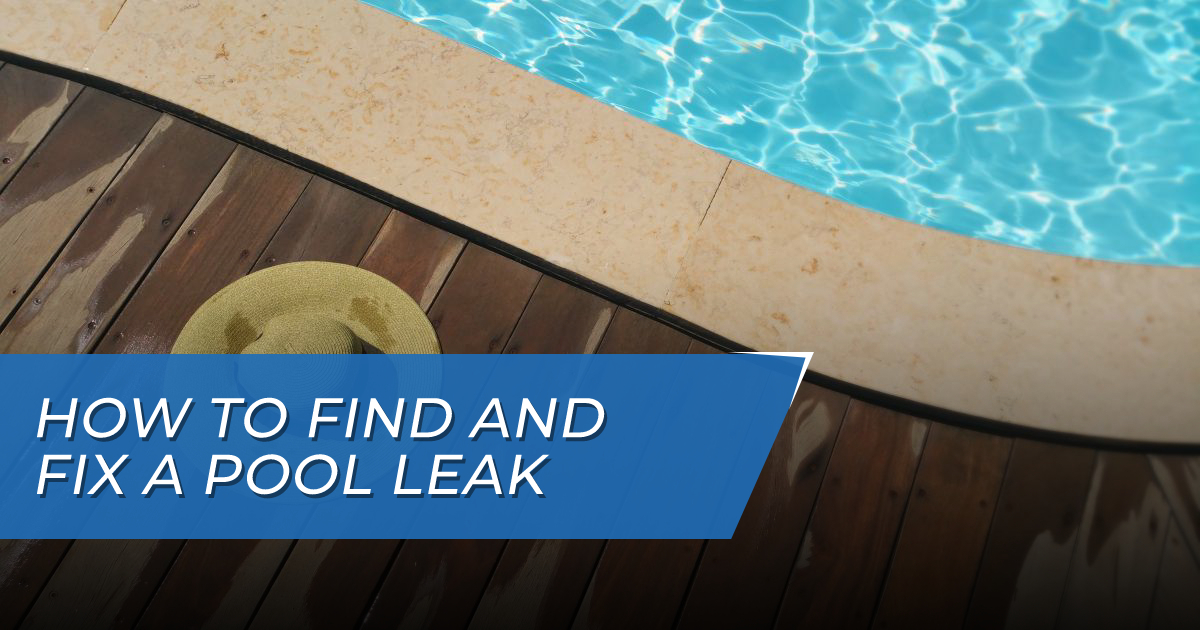How to Find and Fix a Pool Leak
When you have a pool, you usually learn a dozen little things you never knew you needed: how to balance water, what pH your eyes have, how to clean a DE filter or how to fix a pool leak.
Most of the things you learn will be by necessity, because of something you’ve done wrong or not done at all. You’ll learn about algae the first week after forgetting to shock your pool, or you’ll learn about shorting a pump after you’ve left it in a puddle of rainwater.
However, sometimes things just go wrong through no fault of your own. Leaks are hardly ever your fault, for instance. They are also hard to identify and place, and relatively hard to fix without professional help. But if you’re willing to give it a try, here’s what you should know.
Related Article: Leaking Pools: Where Do Most of the Issues Occur?
How Can You Tell Your Pool Is Leaking?
The first thing to do is to make sure there is an actual leak in your pool, and the water is not simply evaporating in very hot weather, for instance.
This is done using by doing the pool leak bucket test. It’s exactly what it sounds like: place a bucket on the top step of your pool, partly submerged, with just a few inches left above the water level. Fill the bucket with water to exactly the same level as the pool around it and mark the water level inside and outside of the bucket. Watch the bucket over several days and see if it loses the same amount of water as the pool. If the pool level is going down, but the water level in your bucket stays the same, you’ve got a problem.
It may sound simple: there’s a leak someplace. But before you learn how to fix your pool leak, you need to locate it. Finding the leak is perhaps the most difficult part of the process. In fact, you may do well to call your pool pros to find the leak for you!
If, however, you want to spot the problem yourself, you have a few tried and true methods to do it.
Related Article: Pool Leak Detection Kits: Do They Work?
How to Find Pool Leak
- Filter tests. If you don’t have a clue where the leak might be, start by determining whether it’s before or after the filter system. Fill the pool, mark the level, and get the filter system going. After 24 hours, check the level and measure how much water you’ve lost. Refill the pool to the initial level, then turn off the filter. Wait another 24 hours and measure the level again. More water lost with the filter on means the leak is past the impeller. More water lost with the filter off means a leak before the impeller. Same water loss either way means structural damage.
- Testing the ground. If the test shows a plumbing problem, you can test the soil for increased moisture, which will likely indicate the place along the line where the leak is located. If you don’t perceive any increased moisture or just don’t want to bother with all that, call a pro. Either way, expect some digging.
- Food dye. If you suspect a structural problem and believe a certain area of the pool to be the source of the leak, you should dive in with a tub of food dye. Wait until the water settles around you and squirt the food dye in the direction of the suspected leak. If there seems to be a suction process, i.e. the food dye seems to be headed in one particular direction, that’s where the leak is.
Vinyl pool leaks are somewhat harder to detect, but a professional has various means to do it. If you’re doing it yourself, look for the places where the vinyl lining is pierced by drains or pool equipment. If you can’t find it in those areas, you’ll just have to take it easy and, well, just look very carefully from end to end.
Related Article: Pool Leaks: Signs Types and Risks of Ignoring the Issues
How to Fix a Pool Leak
Once you’ve identified the source, it’s usually relatively easy to fix the pool leak if you know what you’re doing. Once again, the solution depends on the type of pool you have.
- Vinyl-lined pools: you’ll just need a repair kit. This usually is a patch and glue set you can apply to the problem area, even when underwater after you have identified and cleaned the spot. Vinyl leaks are harder to find but easy to fix.
- Concrete and plaster pools: patching kits are slightly more difficult to operate on concrete and plaster, and you will need to first thoroughly clean the cracked wall, brushing off debris and algae before you apply the patch. You can do this in a full pool, too, though you will need goggles. With these types of pools, however, bear in mind you will first need to mix the putty and then take it into the pool and push it into place. Have a towel handy to smooth out the surface. The more you leave a rough patch in place, the easier it will come off through use, and you’ll be back to square one.
- Fiberglass pools: they’re much less likely to leak in the first place since they are generally seamless. If this is happening, you probably have a leaking return line, gasket, or light housing niche. They’re not difficult to fix, but this will require more specialized work than applying a patch or pushing putty into cracked plaster. It’s probably much safer to call in your pool pros.
Our locations in New Tampa, Lutz, and Land O’ Lakes, have been serving the nearby residents of Pebble Creek, Tampa Palms, Wesley Chapel, Odessa, Seven Springs, Lake Fern, and more for years. We’d be happy to perform our pool leak detection services, so you don’t have to go through all that hassle.

